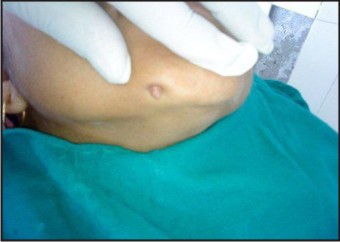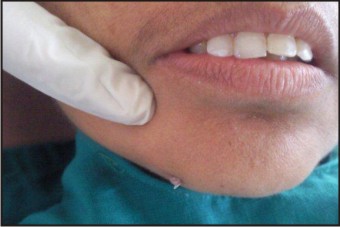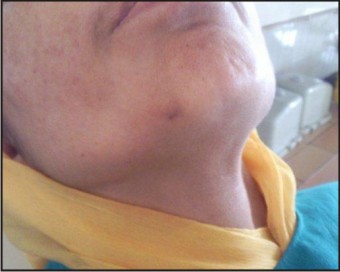|
|
|
| Cutaneous Sinus Tract Of Odontogenic Origin: A Misdiagnosed Lesion |
Anshuman Kharbanda 1 , Rajiv Bali 2 , Pooja Sood 3 , Rashmeen Kaur 4
1 Reader, Dept. of Conservative Dentistry & Endodontics - Luxmi Bai Dental College And Hospital, Patiala
2 Professor & HOD, Dept of Conservative Dentistry & Endodontics - Luxmi Bai Institute of Dental Sciences & Hospital, Patiala, Punjab (India)
3 Senior Lecturer, Dept. of Conservative Dentistry & Endodontics - Luxmi Bai Dental College And Hospital, Patiala
4 Intern, Dept. of Conservative Dentistry & Endodontics - Luxmi Bai Dental College And Hospital, Patiala
|
| Address For Correspondence |
Dr. Anshuman Kharbanda, Reader
Luxmi Bai Dental College & Hospital Patiala, Punjab
Contact : 9815836630 |
| Abstract |
| Although the most common cause of the intermittently suppurating cutaneous sinus tract in the face and neck area is chronic dental infection, chronic draining sinus tracts of the face and neck continue to be a diagnostic challenge. Misdiagnosis of the lesion can lead to cumbersome treatment planning including multiple surgical excisions and biopsies, systemic antibiotic regimens with eventual recurrence. Variety of lesions i.e. Osteomyelitis, actinomycosis, malignancy etc. mimic such a clinical picture. Case of cutaneous facial sinus tract related to mandibular premolar was diagnosed clinically. Nonsurgical endodontic therapy was done as the treatment of choice resulting in successful healing of lesion without any cosmetic treatment. So aim of this report is to present a case report of this common misdiagnosed lesion showing healing of same without any surgical intervention. |
|
| Keywords |
| Cutaneous Sinus Tract, Mandibular Premolar, Management |
|
| Full Text |
Introduction
Cutaneous sinus tracts of dental origin are often initially misdiagnosed and inappropriately treated because of their uncommon occurrence and the absence of symptoms[1]. A review of several reported cases reveal that patients have undergone multiple surgical excisions, radiotherapy, multiple biopsies, and multiple antibiotic regimens, all of which have failed, with recurrence of the cutaneous sinus tract, because the primary dental aetiology was never correctly diagnosed or addressed. Few received cancer-directed therapy before having lesions correctly diagnosed [2],[3]. Even a case which took over 15 years to recognize a dental origin has been reported[4]. Because these lesions are often diagnosed incorrectly, they are also treated ineffectively. This report involves a case of cutaneous facial sinus tract of dental origin, its diagnosis and treatment.
Case Report
A 32 year old woman with no known co-morbidity presented to the department of Conservative, Luxmi Bai Dental College Patiala, for the evaluation of a periodically draining, crusted, fixed, non tender, cord-like, elevated nodule palpable on her right cheek just below the right lower border of mandible. Physical examination revealed a small retracted skin lesion (Fig. 1), (Fig. 2) on her lower part of right cheek which was about 5mm in diameter. She stated that she had felt an induration on her cheek about one year ago and left it untreated because she had no pain. However, as the lesion started to discharge pus during the following months, she then received several treatments from a dermatologist. Inspite of taking large number of antibiotics and antifungal medications both orally and topically, the lesion did not heal and the surgeon had recommended surgery now.
 | Fig. 1 : Showing Skin Lesion On Right Side Of Face And Neck
 |
 | Fig. 2 : Showing Skin Lesion On Right Side Of Face And Neck
 |
Intraoral examination revealed good oral hygiene and grossly carious right mandibular canine. Patient had been wearing a fixed partial denture prosthesis in relation right mandibular first pre molar, second pre molar and first molar from the past one year. Upon examination no tooth was tender to percussion or painful on biting and did not respond to electrical pulp testing. Radiographic examination showed periradicular radiolucency in relation to canine and roots of first premolar, second premolar and first molar. Sinus tract was tracked with a gutta percha cone to the root lesion of first premolar (Fig. 3) as seen in the confirmatory radiograph. (Fig. 4).
 | Fig. 3 : Gutta Percha Passes Through Sinus
 |
 | Fig. 4 : Confirmatory Radiograph Showing Origin If Sinus Present From Root Of Right Mandibular First Premolar
 |
Based on these findings, the patient was diagnosed as having an odontogenic cutaneous sinus tract secondary to chronic periradicular periodontitis of the right mandibular first pre molar tooth. Her consent for endodontic treatment was taken and root canal treatment started. Patient was explained the dental etiology of the sinus formation and its possible management.
After local anaesthesia and rubber dam placement, root canal treatment was initiated with pulp chamber access and biomechanical preparation of the root canals was done. Irrigation during instrumentation was carried out with 1% sodium hypochlorite and EDTA. Calcium hydroxide mixed with chlorhexidine paste was used as the intra canal medicament. After 2 weeks, lesion showed signs of healing. The canal filling with gutta percha and AH plus root canal sealer was performed 3 weeks after the initial appointment (Fig 5) and the lesion showed further healing (Fig 6) After 1month, skin lesion healed (Fig 7) and radiographic examination showed the repair of periapical tissues too.
 | Fig. 5 : Post Operative Radiograph
 |
 | Fig. 6 : Skin Lesion Showing Signs Of Healing After 2 Weeks
 |
 | Fig. 7 : Healed Skin Lesion
 |
The present case report showed the healing of long standing cutaneous sinus and the large skin lesion (may be caused due to suprainfection from the draining pus) and thus lay stress on need of thorough knowledge about the possible dental etiology of cutaneous sinus tract in head and neck area.
Discussion
A sinus tract is an abnormal channel that originates or ends in one opening. An orofacial fistula is a pathologic communication between the cutaneous surface of the face and the oral cavity. Chronic dental periapical infections or dentoalveolar abscesses cause the most common intraoral and extraoral fistulas[6]. As the lesion develops it is usually disregarded to be of dental origin, patient seeks treatment from a dermatologist or general surgeon and often undergoes multiple antibiotic regimens, surgical excisions, biopsies and even radiotherapy[2]. Misdiagnosis adds to the chronicity of the lesion and has profound effect on facial esthetics due to unnecessary treatment resulting in cutaneoues scarring and dimpling. Only 50% of patients with cutaneous odontogenic sinus tracts have a history of toothache. Most patients are unaware of an associated dental problem[1],[5], thus delaying the correct diagnosis of the cutaneous lesion with its primary odontogenic origin. The sites of dentocutaneous fistula are usually anatomically close to the causative tooth. Of reported cases, 80% involved mandibular teeth of which half were anterior teeth, producing sinus tracts in the submental and chin sites[7].
Other sites of extra-oral drainage of odontogenic origin are the cheek, canine space, nasolabial fold, nose, upper lip, and inner canthus of the eye [1],[3],[7]. Mandibular incisors and cuspids typically drain to the chin or submental region, and premolar and molar infections typically drain above the inferior border in the submandibular region of the anterior triangle of the neck [8]. Occasionally the opening of the sinus tract may be found at a far distance from the dental infection. Endelman[9] described a patient in whom a sinus from a tooth infection opened on the chest wall and another on the upper one third of the thigh. Carious exposure with bacterial invasion of the tooth pulp leading to a periapical abscess is the most common cause of dentocutaneous sinus tracts. The inflammation destroys the cancellous alveolar bone and proceeds along the periosteum until perforation occurs. An intraoral or extraoral sinus can develop, depending on the path of the inflammation, which is dictated by surrounding muscular attachments and fascial planes. The cutaneous lesion may develop as early as a few weeks [10] or as late as 30 years [11]. Evaluation of a cutaneous sinus tract must begin with a thorough history and awareness that any cutaneous lesion of the face and neck could be of dental origin.
Dentocutaneous sinus tracts appear as soft, slightly depressed nodules, often fixed to underlying structures, with a central opening from which fluid can be expressed. Palpation of the surrounding tissue may produce pus, which supports the diagnosis. Intraoral and dental examinations are critical for making the diagnosis. In particular, the examiner should look for dental caries or restorations and periodontal disease. Early radiographs can prevent unnecessary surgeries when the teeth appear clinically normal. A panoramic or periapical radiograph will show radiolucency at the apex of the infected tooth. Recognition of a sinus tract origin is the first step in diagnosis. Intraoral periapical radiographs should be taken routinely when such lesions are present, preferably with a gutta-percha cone threaded into the sinus tract. Because of gutta-percha's radiopacity, the source of the infection will be revealed. Any chronic suppurative lesion on the middle or lower portion of the face should be investigated for possible dental cause. Most infections are polymicrobial, and culture often yields growth of anaerobes or facultative anaerobes. The differential diagnosis[1],[10] should include traumatic lesions, fungal and bacterial infections, neoplasms presence of a foreign body, local skin infection (carbuncle and infected epidermoid cyst), pyogenic granuloma, chronic tuberculosis lesion, osteomyelitis, actinomycosis, and gumma of tertiary syphilis. Rare entities to be included in the differential diagnosis are developmental defects of thyroglossal duct origin or branchial cleft, salivary gland and duct fistula, dacryocystitis, and suppurative lymphadenitis.
Root canal therapy is the treatment of choice if the tooth is restorable. Extraction is indicated for nonrestorable teeth. Once the primary odontogenic aetiology has been properly eliminated or removed, the sinus tract and cutaneous lesion usually resolve within a few weeks without treatment. Systemic antibiotic administration is neither necessary nor recommended in patients with cutaneous odontogenic sinus tracts who have an intact immune system. Antibiotics may be used as an adjunct to endodontic therapy in the cases of diabetes, immunosuppression, or systemic signs of infection such as fever. Antibiotic therapy alone will not be effective in these cases because of the absence of adequate circulation in a necrotic pulp system and abscess. After root canal therapy, the cutaneous lesion usually resolves in 1 to 2 weeks.
Conclusion
Chronic dental infection is one of the most common causes of fistulae of the face and neck. An understanding of the pathogenesis of cutaneous fistulae arising from dental infections will lead to proper early diagnosis and treatment without unnecessary surgery. The case presented here shows that cutaneous odontogenic sinus tracts are still being misdiagnosed and that treatment applied is inappropriate. The case illustrates the need for cooperative diagnostic referrals between physicians and dentists, and highlights the need for thorough diagnostic procedures that should always include a dental examination.
References
1. Cioffi GA, Terezhalmy GT, Parlette HL. Cutaneous draining sinus tract: an odontogenic etiology. Jam Acad Dematol 1986; 14: 94-100.
2. Sakimoto E & Stratigos GT. Bilateral cutaneous sinus tracts of dental etiology: report of a case. J of Oral Surg 1973; 31: 70-74.
3. Mc walter GM, Alexander JB, Delrio CE, Knott JW. Cutaneous sinus tracts of dental etiology. Oral Surg, Oral Med, Oral Path 1988; 66: 608-614.
4. Tidwell E, Jenkins JD, Ellis CD, Hutson B, Cederberg RA. Cut aneous odontogenic sinus tract to the chin: a casereport. Int Endod J 1997; 30: 352- 355.
5. Caliskan MK, Sen BH, Ozinel MA Treatment of extraoral sinus tracts from traumatized teeth with apical periodontitis. Endod Dent Traumatol 1995; 11: 115-120.
6. Bernick SM & Jensen JR Chroni draining extraoral fistula of 32 years duration. J Oral Max Surg 1969; 27: 790-794.
7. Hodges TP, Cohen DA, Deck D Odontogenic sinus tracts. Americ Pract Family 1989; 40: 113-116.
8. Busselberg LF, Horton CE, Carraway JH. Cysts and sinuses of the face resulting from dental abscesses. Surg Gynecol Obstet 1979; 149: 717-718.
9. Endelman J. Dental pathology. 2nd ed. St Louis, CV Mosby, P264.
10. Spear KL, Sheridan PJ, Perry HO Sinus tracts to the chin and jaw of dental origin. J American Academy of Dermatol 1983; 8: 486-92.
11. Cohen PR & Eliezri YD Cutaneous odontogenic sinus simulating a basal cell carcinoma: case report and literature review. Plastic and Reconstructive Surgery 1990; 86: 123-7. |
|
|
|
|
|
|